The Big
What is the Large Bang Theory?
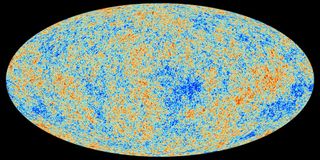
What was the Big Blindside?
The Big Bang Theory is the leading explanation for how the universe began. Simply put, information technology says the universe as we know it started with an infinitely hot and dense single point that inflated and stretched — first at unimaginable speeds, and and then at a more measurable rate — over the side by side 13.8 billion years to the still-expanding creation that we know today.
Existing engineering science doesn't still allow astronomers to literally peer back at the universe's birth, much of what we understand about the Large Bang comes from mathematical formulas and models. Astronomers tin can, yet, run into the "echo" of the expansion through a phenomenon known every bit the cosmic microwave groundwork.
While the majority of the astronomical customs accepts the theory, there are some theorists who have alternative explanations besides the Big Bang — such as eternal inflation or an oscillating universe.
Related: Some supermassive black holes may contain fingerprints from the Big Bang
The Big Bang: the birth of the universe
Around xiii.7 billion years ago, everything in the unabridged universe was condensed in an infinitesimally small singularity, a point of infinite denseness and heat.
All of a sudden, an explosive expansion began, ballooning our universe outwards faster than the speed of light. This was a period of cosmic aggrandizement that lasted mere fractions of a 2nd — about 10^-32 of a second, according to physicist Alan Guth's 1980 theory that changed the mode we remember nearly the Big Bang forever.
When catholic inflation came to a sudden and still-mysterious end, the more classic descriptions of the Big Blindside took hold. A flood of thing and radiations, known as "reheating," began populating our universe with the stuff we know today: particles, atoms, the stuff that would become stars and galaxies and so on.

This all happened within only the first 2nd after the universe began, when the temperature of everything was notwithstanding insanely hot, at about 10 billion degrees Fahrenheit (v.5 billion Celsius), according to NASA. The cosmos now contained a vast array of fundamental particles such as neutrons, electrons and protons — the raw materials that would become the building blocks for everything that exists today.
This early "soup" would take been impossible to really encounter because it couldn't hold visible calorie-free. "The gratis electrons would have caused light (photons) to besprinkle the way sunlight scatters from the water droplets in clouds," NASA stated. Over fourth dimension, nonetheless, these costless electrons met up with nuclei and created neutral atoms, or atoms with equal positive and negative electric charges.
This allowed low-cal to finally shine through, about 380,000 years after the Big Blindside.
Sometimes called the "afterglow" of the Big Bang, this low-cal is more properly known as the cosmic microwave background (CMB). It was first predicted by Ralph Alpher and other scientists in 1948 but was constitute only by accident nearly twenty years subsequently.
Related: Images: Peering dorsum to the Large Bang & early universe
This accidental discovery happened when Arno Penzias and Robert Wilson, both of Bong Telephone Laboratories in New Jersey, were edifice a radio receiver in 1965 and picked up college-than-expected temperatures, co-ordinate to NASA. At get-go, they thought the anomaly was due to pigeons trying to roost inside the antenna and their waste, only they cleaned upwards the mess and killed the pigeons and the anomaly persisted.
Simultaneously, a Princeton University team led past Robert Dicke was trying to find evidence of the CMB and realized that Penzias and Wilson had stumbled upon it with their strange observations. The two groups each published papers in the Astrophysical Journal in 1965.
Reconstructing the universe'south infancy
Because we can't run into information technology directly, scientists have been trying to figure out how to "see" the Big Bang through other measures. In one case, cosmologists are pressing rewind to reach the first instant after the Large Bang past simulating four,000 versions of the current universe on a massive supercomputer.
"We are trying to exercise something like guessing a infant photo of our universe from the latest picture," written report leader Masato Shirasaki, a cosmologist at the National Astronomical Observatory of Nippon (NAOJ), wrote in an email to Live Science.
With what is known virtually the universe today, the researchers on this 2021 written report compared their understanding of how gravitational forces interacted in the primordial universe with their thousands of computer-modeled universes. If they could predict the starting weather of their virtual universes, they hoped to be able to accurately predict what our own universe may accept looked like dorsum at the beginning.
Other researchers have chosen different paths to interrogate our universe'due south beginnings.
In a 2020 study, researchers did and then by investigating the carve up betwixt matter and antimatter. In the study, not yet peer-reviewed, they proposed that the imbalance in the amount of matter and antimatter in the universe is related to the universe'southward vast quantities of dark matter, an unknown substance that exerts influence over gravity and yet doesn't interact with light. They suggested that in the crucial moments immediately after the Big Bang, the universe may have been pushed to make more matter than its inverse, antimatter, which then could have led to the formation of night matter.
Read more: What came before the Big Blindside?
The age of the universe
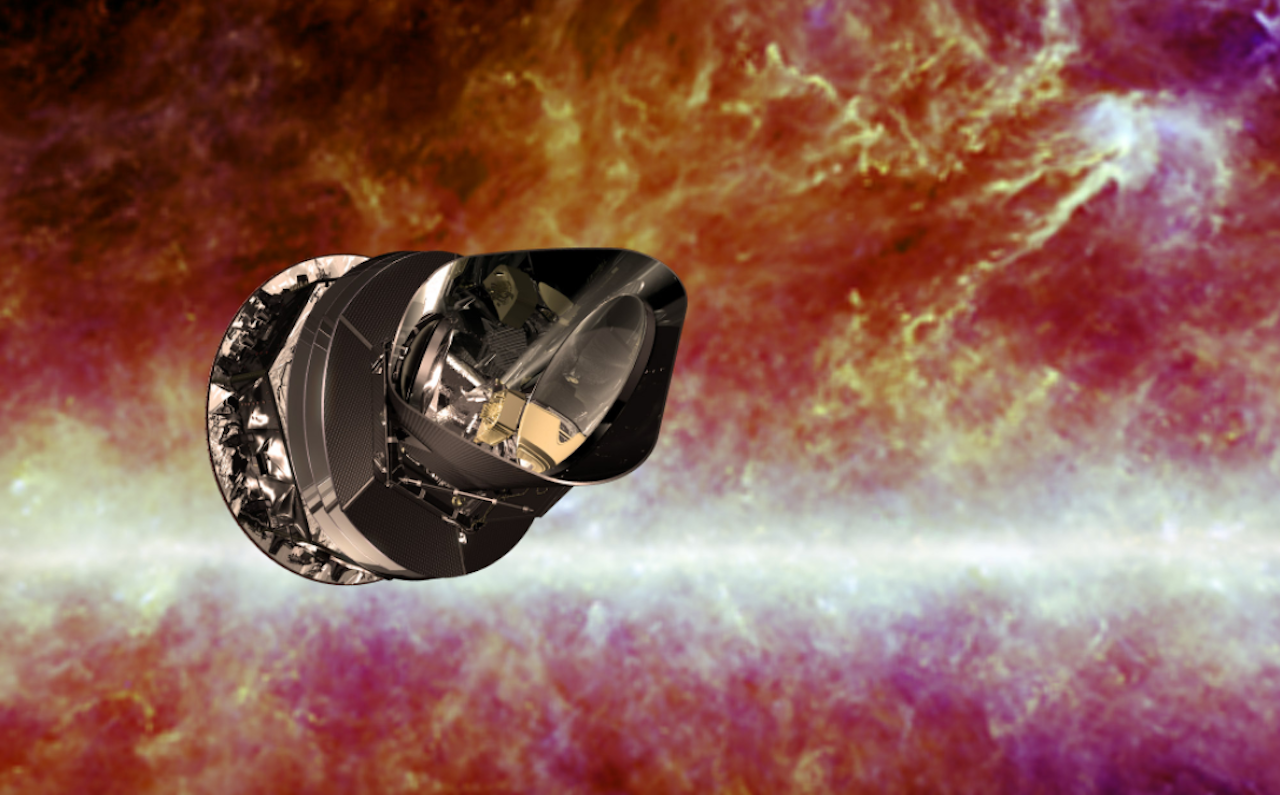
The CMB has been observed by many researchers now and with many spacecraft missions. I of the most famous infinite-faring missions to do so was NASA'south Cosmic Groundwork Explorer (COBE) satellite, which mapped the sky in the 1990s.
Several other missions have followed in COBE's footsteps, such as the BOOMERanG experiment (Balloon Observations of Millimetric Extragalactic Radiation and Geophysics), NASA's Wilkinson Microwave Anisotropy Probe (WMAP) and the European Space Bureau's Planck satellite.
Planck'southward observations, beginning released in 2013, mapped the CMB in unprecedented detail and revealed that the universe was older than previously idea: 13.82 billion years quondam, rather than 13.vii billion years former. The enquiry observatory's mission is ongoing and new maps of the CMB are released periodically.
Related: How erstwhile is the universe?
The maps give rise to new mysteries, still, such as why the Southern Hemisphere appears slightly redder (warmer) than the Northern Hemisphere. The Big Bang Theory says that the CMB would be mostly the same, no thing where y'all look.
Examining the CMB also gives astronomers clues as to the composition of the universe. Researchers think most of the creation is made up of matter and energy that cannot be "sensed" with our conventional instruments, leading to the names "dark matter" and "dark energy." It is thought that merely 5% of the universe is made upward of matter such as planets, stars and galaxies.
Observing gravitational waves
While astronomers report the universe'south beginnings through creative measures and mathematical simulations, they've also been seeking out proof of its rapid inflation. They accept done this by studying gravitational waves, tiny perturbations in space-time that ripple outwards from great disturbances like, for instance, two blackness holes colliding, or the birth of the universe.
Co-ordinate to leading theories, in the outset second after the universe was born, our creation ballooned faster than the speed of light. (That, by the way, does not violate Albert Einstein'southward speed limit. He one time said that light speed is the fastest annihilation can travel within the universe — simply that argument did non apply to the inflation of the universe itself.)
As the universe expanded, it created the CMB and a similar "background noise" made upwards of gravitational waves that, similar the CMB, were a sort of static, detectable from all parts of the sky. Those gravitational waves, according to the LIGO Scientific Collaboration, produced a theorized barely-detectable polarization, 1 type of which is called "B-modes."
In 2014, astronomers said they had found show of B-modes using an Antarctic telescope called "Groundwork Imaging of Catholic Extragalactic Polarization," or BICEP2.
"We're very confident that the signal that we're seeing is real, and information technology'due south on the sky," pb researcher John Kovac, of the Harvard-Smithsonian Centre for Astrophysics, told Space.com in March 2014.
But past June, the same team said that their findings could take been altered by galactic grit getting in the way of their field of view. That hypothesis was supported by new results from the Planck satellite.
By Jan 2015, researchers from both teams working together "confirmed that the Bicep betoken was by and large, if not all, stardust," the New York Times said.

Withal, since then gravitational waves take not simply been confirmed to exist, they have been observed multiple times.
These waves, which are non B-modes from the nascence of the universe but rather from more recent collisions of black holes, have been detected multiple times past the Light amplification by stimulated emission of radiation Interferometer Gravitational-Moving ridge Observatory (LIGO), with the beginning-e'er gravitational wave detection taking place in 2016. As LIGO becomes more sensitive, information technology is anticipated that discovering black hole-related gravitational waves will be a fairly frequent effect.
Expansion vs explosion
Although the Large Bang is oft described as an "explosion", that'south a misleading image. In an explosion, fragments are flung out from a central point into a pre-existing space. If y'all were at the central indicate, you'd run across all the fragments moving abroad from y'all with roughly the same speed.
But the Large Bang wasn't like that. It was an expansion of space itself – a concept that comes out of Einstein's equations of general relativity, but has no counterpart in the classical physics of everyday life. It means that all the distances in the universe are stretching out at the same rate. Whatever two galaxies separated by altitude Ten are receding from each other at the same speed, while a milky way at altitude 2X recedes at twice that speed.
The universe's continued expansion
The universe is not only expanding, but expanding faster. This means that with fourth dimension, nobody will be able to spot other galaxies from Globe, or any other vantage point inside our milky way.
"We will run across distant galaxies moving away from us, but their speed is increasing with time," Harvard University astronomer Avi Loeb said in a March 2014 Space.com article.
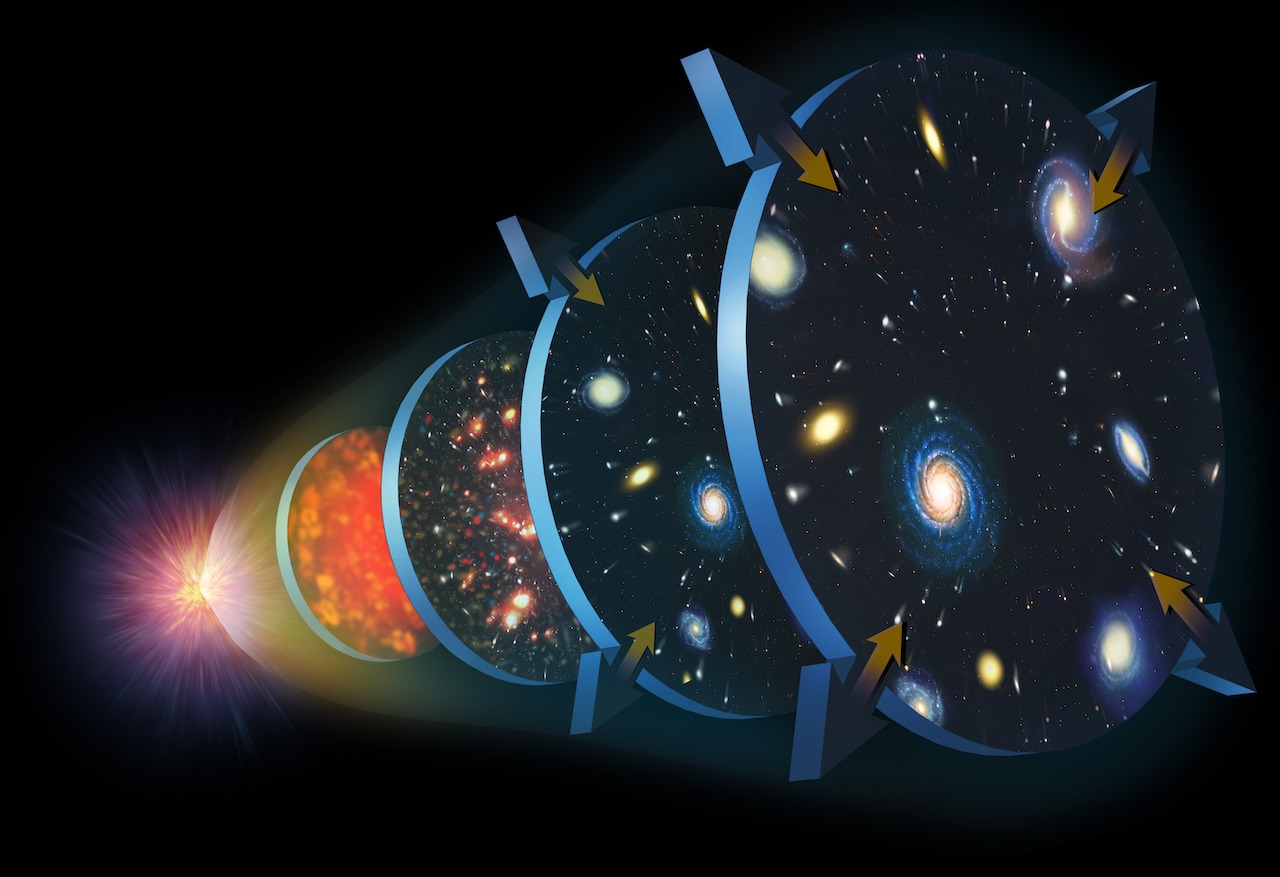
"So, if you wait long enough, eventually, a distant galaxy will attain the speed of light. What that means is that fifty-fifty light won't be able to bridge the gap that's being opened between that galaxy and united states. At that place's no mode for extraterrestrials on that milky way to communicate with u.s.a., to send whatever signals that will reach us, one time their milky way is moving faster than light relative to us."
Related: Big Bang Theory: v weird facts about seeing the universe'due south nascence
Some physicists also propose that the universe we experience is merely one of many. In the "multiverse" model, dissimilar universes would coexist with each other like bubbles lying adjacent. The theory suggests that in that first large push of aggrandizement, different parts of space-fourth dimension grew at different rates. This could have carved off dissimilar sections — different universes — with potentially dissimilar laws of physics.
"It's difficult to build models of inflation that don't lead to a multiverse," Alan Guth, a theoretical physicist at the Massachusetts Institute of Technology, said during a news conference in March 2014 apropos the gravitational waves discovery. (Guth is non affiliated with that study.)
"It'southward not incommunicable, so I think there's even so certainly enquiry that needs to exist washed. Simply most models of inflation do lead to a multiverse, and evidence for aggrandizement will be pushing u.s. in the direction of taking [the idea of a] multiverse seriously."
While we tin can understand how the universe we encounter came to be, it's possible that the Large Blindside was not the first inflationary menses the universe experienced. Some scientists believe we alive in a creation that goes through regular cycles of inflation and deflation, and that we just happen to exist living in one of these phases.
JWST and the Big Blindside
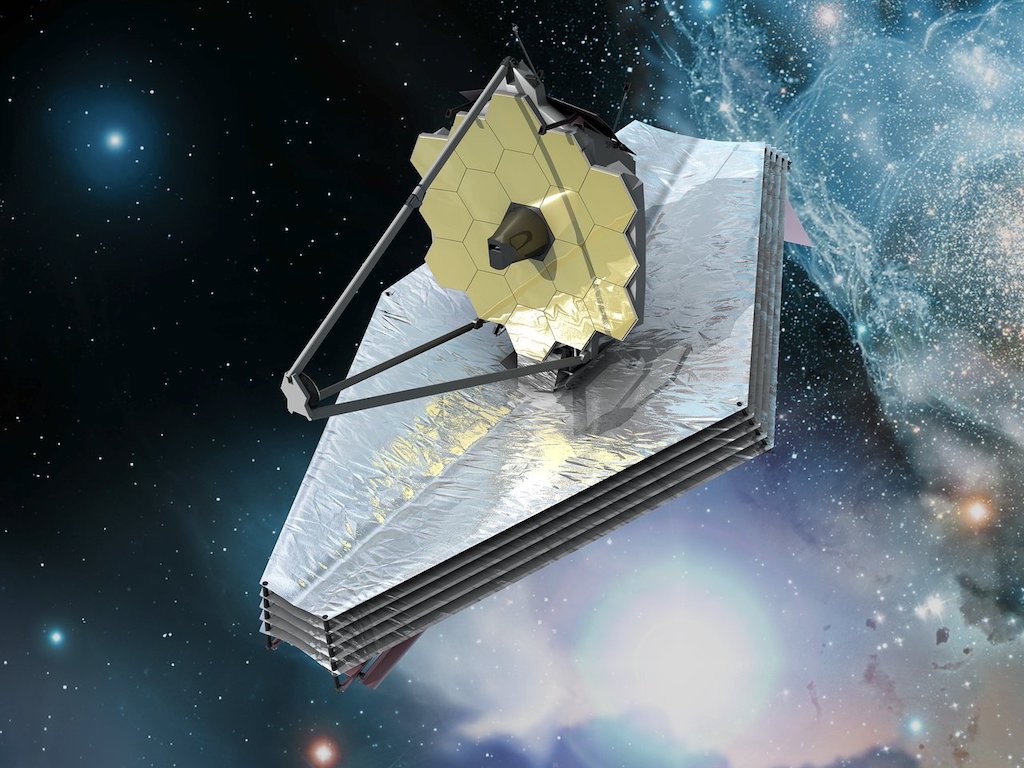
A telescope is almost like a time machine, allowing us to peer back into the afar past. With the aid of Hubble, NASA has shown us galaxies as they were many billions of years ago – and Hubble'south successor, the James Webb Space Telescope, has the ability to wait even deeper into the past.
NASA hopes it will run across all the way dorsum to when the first galaxies formed, nearly xiii.six billion years ago. And unlike Hubble, which sees mainly in the visible waveband, JWST is an infrared telescope – a big advantage when looking at very distant galaxies. The expansion of the universe means that waves emitted from them are stretched out, then light that was emitted at visible wavelengths actually reaches us in the infrared.
The Large Bang Theory: becoming a household name
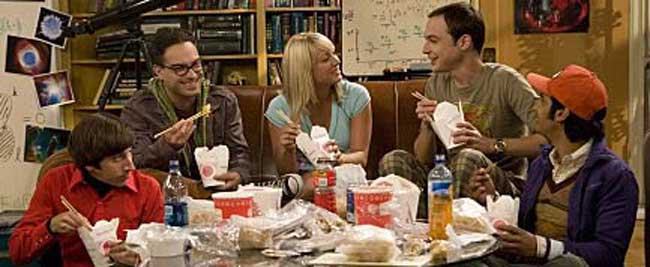
The proper noun "Big Blindside Theory" has been a popular way to talk near the concept among astrophysicists for decades, just it hit the mainstream in 2007 when a comedy T.V. show with the same name premiered on CBS.
Running for 279 episodes over 12 seasons, the show "The Big Bang Theory" followed the lives of a grouping of scientists, which included physicists, astrophysicists and aerospace engineers. The bear witness explores the group'southward nerdy friendships, romances and squabbles. Its first flavor premiered on Sept. 24, 2007, and the show officially ended on May xvi, 2019.
Although the bear witness itself didn't swoop too much into actual science, the showrunners did hire UCLA astrophysicist David Saltzberg as a science consultant for the entire run of the show, according to Science magazine. Science consultants are often hired for sci-fi and science-related shows and movies to help keep certain aspects realistic.
Cheers to Saltzberg, the characters' vocabulary included a host of science jargon and the whiteboards in the background of labs, offices and apartments throughout the prove were filled with a variety of equations and information.
Over the grade of the testify, Saltzberg said, those whiteboards became coveted space as researchers sent him new work that they hoped might be featured there. In one episode, Saltzberg recalled, new evidence of gravitational waves was scrawled across a whiteboard that ostensibly belonged to famed physicist Steven Hawking, who also canonical the text.
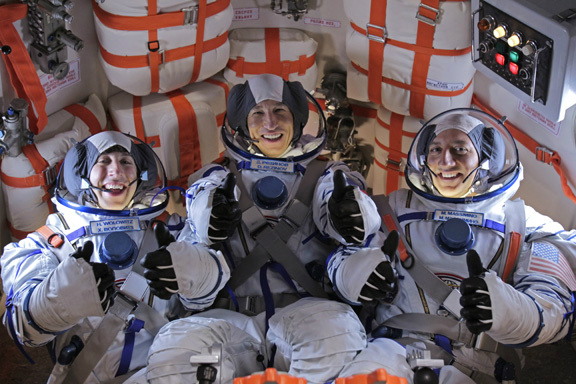
The testify took some liberties, every bit it was fictional. This included fabricating some new scientific concepts and fictionalizing the politics of Nobel prizes and academia, co-ordinate to Fermilab physicist Don Lincoln.
Related: How 'The Big Bang Theory' sent Howard Wolowitz to infinite
Notably, several characters in the series take trips. 1 episode sees main characters Leonard, Sheldon, Raj and Howard set out on a research trek to the Arctic — many physics experiments are best performed at or near the farthermost environments of the poles. Another put aerospace engineer Howard on a Russian Soyuz spacecraft and, later, a model of the International Space Station along with existent-life astronaut Mike Massimino.
Additional resources
Discover more than about CMB on NASA'southward webpage on putting the Big Bang theory to the examination. NASA have too put together what the Large Bang might have looked it in this animation. Here's 5 quick facts nigh the Large Bang from How It Works mag.
This article was updated on May 17, 2021 by Space.com contributor Vicky Stein. This article was updated again in 2021 by Space.com senior author Chelsea Gohd.
Join our Space Forums to continue talking space on the latest missions, night sky and more! And if you have a news tip, correction or annotate, let us know at: community@space.com.
Source: https://www.space.com/25126-big-bang-theory.html
0 Response to "The Big"
Post a Comment